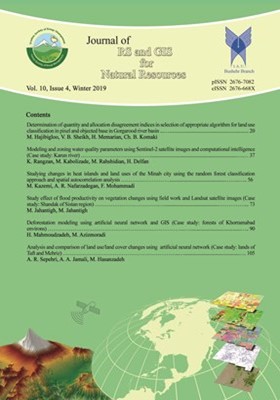Modeling and zoning water quality parameters using Sentinel-2 satellite images and computational intelligence (Case study: Karun river)
Subject Areas : Applications in water resources managementKazem Rangzan 1 * , Mostafa Kabolizade 2 , Mohsen Rahshidian 3 , Hossein Delfan 4 *
1 - Assoc. Prof. Department of Remote Sensing and GIS, Faculty of Earth Sciences, Shahid Chamran University of Ahvaz, Iran
2 - Assist. Prof. Department of Remote Sensing and GIS, Faculty of Earth Sciences, Shahid Chamran University of Ahvaz, Iran
3 - Lecturer, Department of Surveying Engineering, Faculty of Civil Engineering, Jundi Shapur University of Technology, Dezfoul, Iran
4 - MSc. Student, Department of Remote Sensing and GIS, Faculty of Earth Sciences, Shahid Chamran University of Ahvaz, Ahvaz, Iran
Keywords: Sentinel-2 images, Artificial Neural Network (ANN), Karun river, Monitoring, Adaptive Neuro Fuzzy Inference System (ANFIS),
Abstract :
Considering the progress made in remote sensing technology, collecting information on the quality of surface water resources by this technology, while reducing the cost and time of traditional sampling, can monitor all surface water zones. In this study, the Sentinel-2 satellite images were used to estimate the concentration of acidity, bicarbonate and sulfate parameters. Initially, Sentinel-2 satellite images were pre-processing and then bands and spectral indexes were determined to identify the significant relationship between the parameter values of water quality and images using the multivariate regression method. In the next stage, using Artificial neural network (ANN) and Adaptive Neuro fuzzy inference system (ANFIS) models, the relationship between Sentinel-2 satellite images and water quality parameters were modeled and then their accuracy was calculated for real values. The results showed that in the modeling of sulfate parameter using Sentinel-2 satellite, ANFIS model with relative error equal to 0.0773 and RMSe equal to 0.8014 has a higher accuracy compared to ANN models with relative error equal to 0.1581 and RMSe equal to 1.2477. While, the relative error of the results of the ANN model are obtained 0.0064 and 0.0556 for acidity and bicarbonate parameter, respectively, and RMSe is equal to 0.0702 and 0.2691, respectively. The ANFIS model has a relative error of 0.0165 and 0.0722, and RMSe is 0.1975 and 0.3037 for acidity and bicarbonate parameter, respectively. Finally, using satellite images, the mentioned models were applied to prepare a qualitative map of each parameter along the part of the Karun river.
_||_

